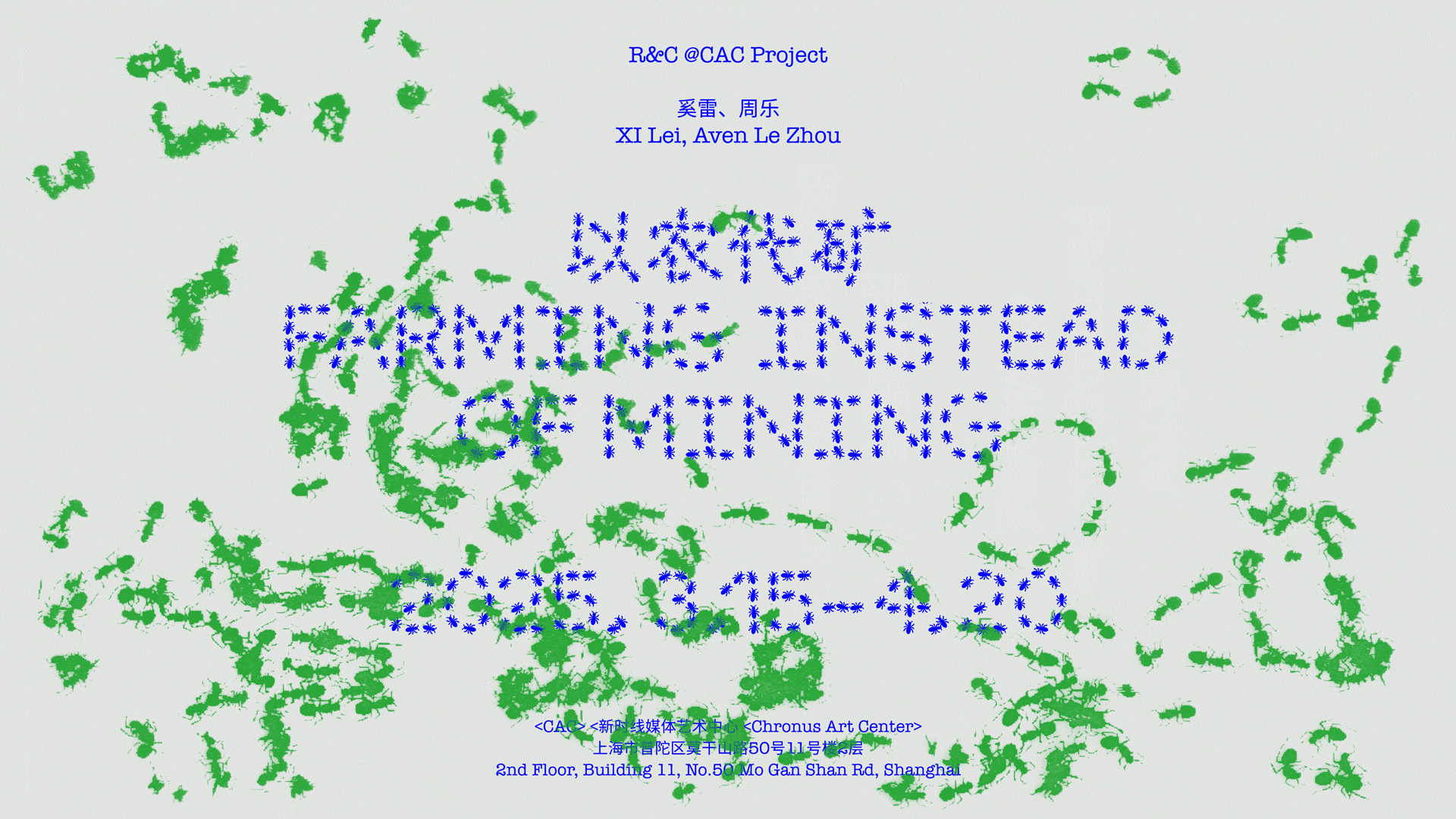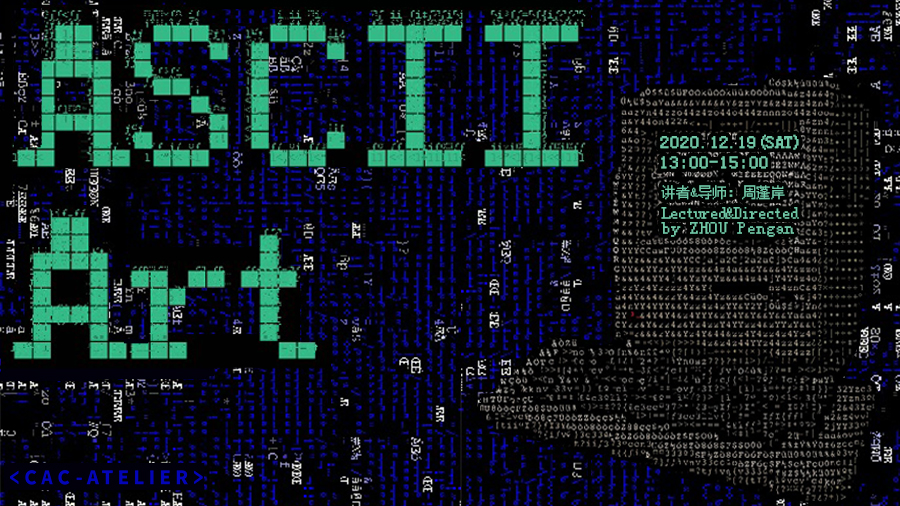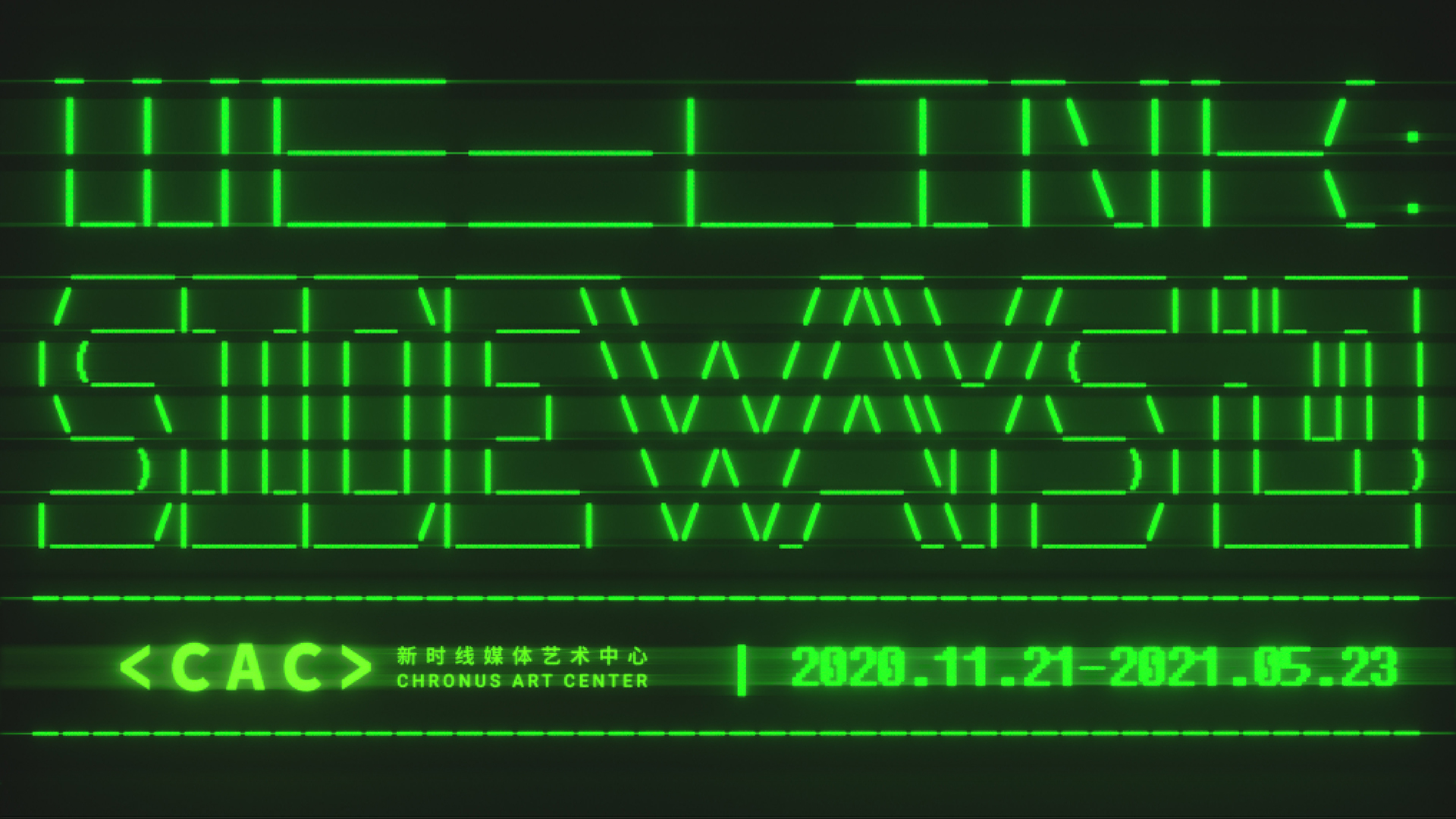
ZHANG Ga
History often began on the periphery and the fringe and ended up sucked in by a centripetal pull, becoming once again the story of the core. It seems the inevitable power of gravity.
When in the mid-1990s the Museum of Modern Art reluctantly set up its innocent looking website at the persuasion of Barbara London, MoMA’s evangelist of media art, and a number of other upward-looking curatorial staff[1], the Thing.net, which had recently moved to the still dilapidated West Chelsea neighborhood, had been already, along with its European sister nodes, operating on a different cultural front for some time and its Berlin-styled monochrome website with plenty of perl scripts under the belt, compared to MoMA’s rudimentary html pages, appeared sophisticated enough to rival the mammoth establishment, at least at face value and for the time being.
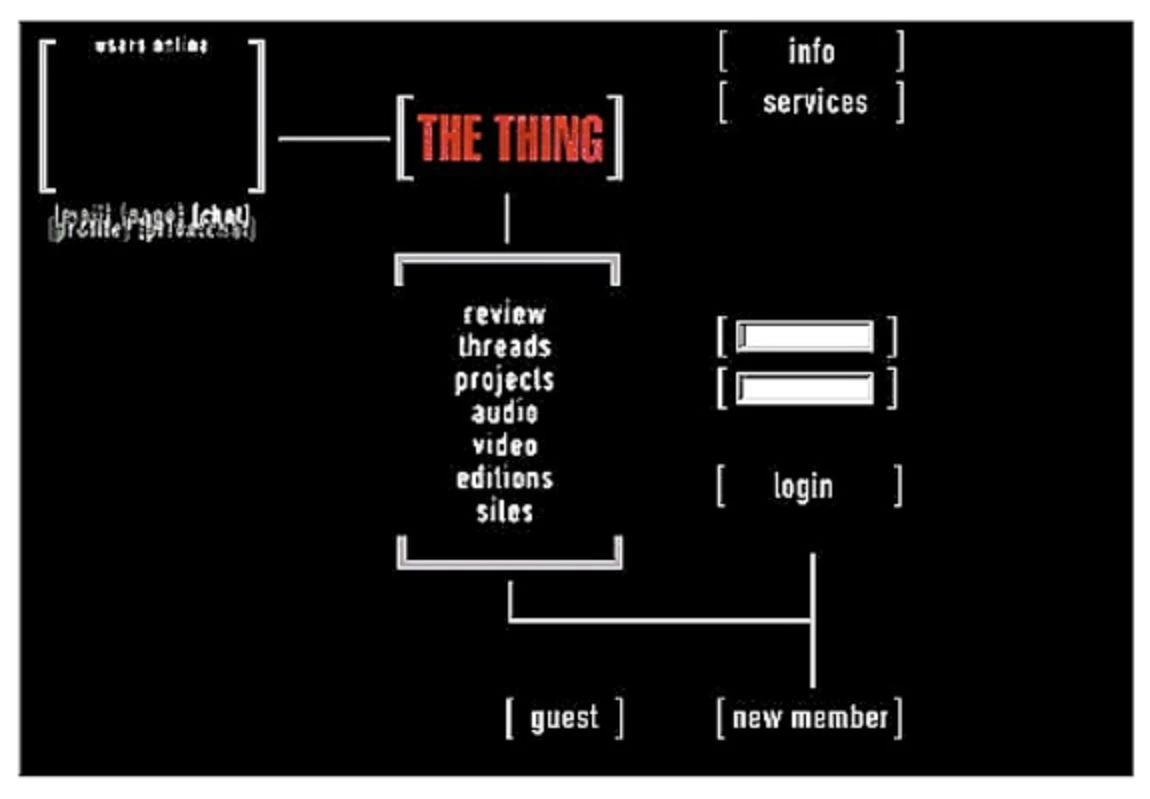 Wolfgang Staehle, thing.net, circa1998
Wolfgang Staehle, thing.net, circa1998
image source: Wikimedia Commons
These days are long gone – today, The Thing is still frequented by its old-time confrère, while MoMA has moved on to command the attention of millions online with its immense collection digitized and through a sleek interface design and elaborate web technologies. The recent impeccable installation of Jodi’s My%Desktop (2002) has again proved MoMA’s indisputable licensing power of rectifying the fringe to the center and canonizing the once avant-garde, transforming and elevating the one-person (desktop) show to a collective immersion of visual ensemble.
Net.art, and netart or net art (a serendipitously adopted term with a mélange of connotations describing its hybrid contention by origin and heterogeneity by nature[2]), was also later realized by many to have been the last art movement of the 20th century, albeit without a collectively concerted manifesto.[3]
By 1997, a few short years after its emergence, net art seemed to have already “reached a dead end or a turning point.”[4] For according to Dieter Daniels, the three fundamental principles that had been pursued by the instigators of early net art, i.e.: “construction of an independent, partly self-designed technological infrastructure; formation of a self-organized community and the collective design and testing of a corresponding model of discourse; development of a form of art specific to the network, exploring the medium’s potential in an experimental, self-reflective way,”[5] had all but been sabotaged by precisely the opposite of what the pioneering visionaries had strived for: commodification of network and territorialization of the online milieu. The web had turned into a distributional and promotional channel propagated by art of all forms and kinds, not to mention that the internet had become the Internet and the economic engine of the next few decades, and more.[6]
A signifying indicator of such a demise evidently was also the eventual institutional admission of net art into the 1997 Documenta X while at the same time the miserable failure of the institution’s comprehension of the medium. The presentation was kept apart from the rest of the artworks in an isolated office-like blue-colored room, and the web works were installed on a local area network that would inevitably lead people browsing hypertext links to dead ends.[7]
But this presumable deadend also enabled the birth of, probably, one of the best known, or most infamous works of net art: Documenta Done. Upon hearing that Documenta organizers were to take down its official website and package it, along with online projects, and sell it as a CD Rom, Vuk Ćosić, the Slovenian net artist, cloned the entire website prior to it being taken offline and reposted on his own sever with a pseudo press release under the sensational headline “Eastern European Hacker Steals ‘Documenta’ Website.” He then redistributed the Documenta website for free and exhibited it on many occasions and configurations. Asked of his motivation, in lieu of various speculations by commentators that saw the stunt as a typical Dadaist prank or else as an institutional critique of its digital reincarnation, Ćosić replied, “So obviously we were looking for mischief, ways to subvert it.”[8]
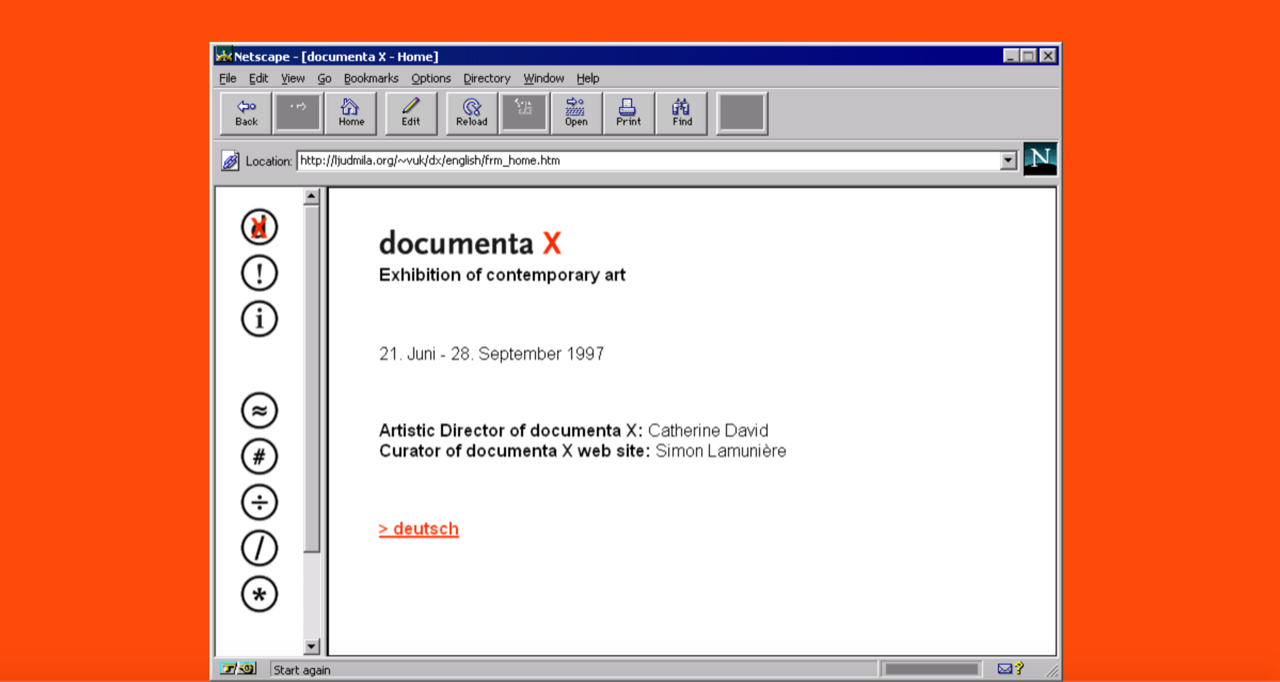 Documenta Done
Documenta Done
image source: https://sites.rhizome.org/anthology/documenta-done.html
This exhibition takes the purported net art’s “dead end” as a new starting point to chart a discursive trajectory of the practices since then, in the many manifestations of network-based art. Instead of prescribing it a categorical definition, the exhibition attempts to uncover the variegated developments, diverse strategies, critical positions and aesthetic experiments after the crash of the dot.com bubble, amidst the prevalence of neoliberalism and cognitive capitalism, and the rise of populism and nationalism. Sideways reveals the continuum of the Avant-garde “nettitudes” inherent in the works of these net artists.
It is within this tradition of mischief that net art marked a particular strand of genealogy with the historical avant-garde. Much like Documenta Done, in the guise of a Dadaist prank, launched a roundabout attack on the artworld’s powerful, subsequent works such as Bumplist (Jonah Brucker-Cohen, Mike Bennett, 2003) would devise a mechanism to boot out a subscriber as soon as another user signed up, in order to insinuate a playful take on law and order, or else as in those deceptive clones endlessly propagated in the work of TraceNoizer – Disinformation on Demand (LAN, 2001), in which users would let go viral a piece of false information so as to perform a counter-surveillance stunt. A more recent incarnation of such an impulse to do away with capitalist consumerism can be found in The Internet . Click (Jonas Lund, 2017). Harron Mirza’s triptych of live feeds of Instagram via VPN (Inappropriate Appropriation, Biter, Toy, 2019) alludes to a complex exchange of artefacts by which we have learned that knowledge sharing is never wishfully innocent, and the global network is always locally conditioned. The seemingly innocuous exercises of artists’ whims underlie a playfully recalcitrant instinct that shares its genes with the fanfares of Cabaret Voltaire[9] and the uncanny persona of Rrose Sèlavy.[10]
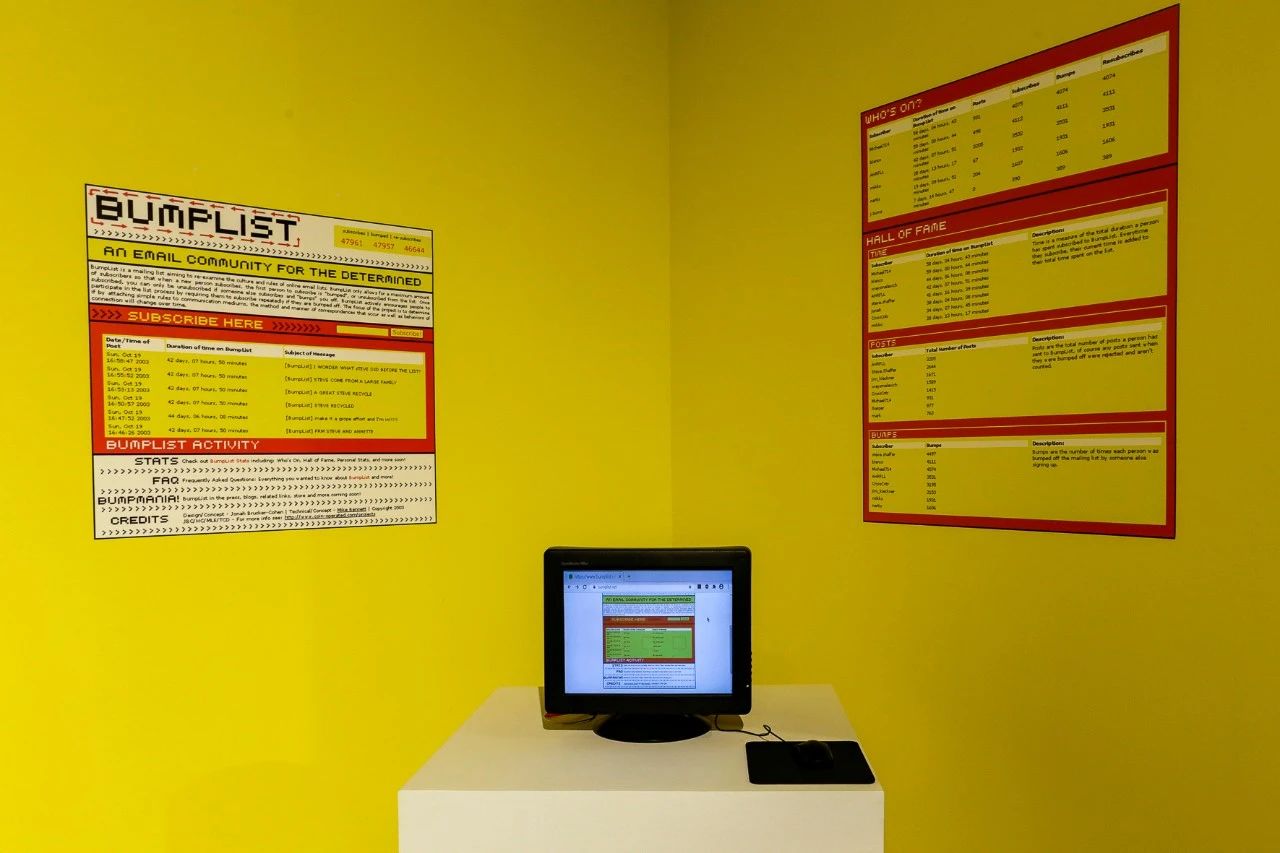 Jonah Brucker-Cohen, Mike Bennett, BumpList: An Email Community for the Determined, 2003,installation view ©CAC
Jonah Brucker-Cohen, Mike Bennett, BumpList: An Email Community for the Determined, 2003,installation view ©CAC
 LAN, TraceNoizer----Disinformation on Demand , 2001,installation view ©CAC
LAN, TraceNoizer----Disinformation on Demand , 2001,installation view ©CAC
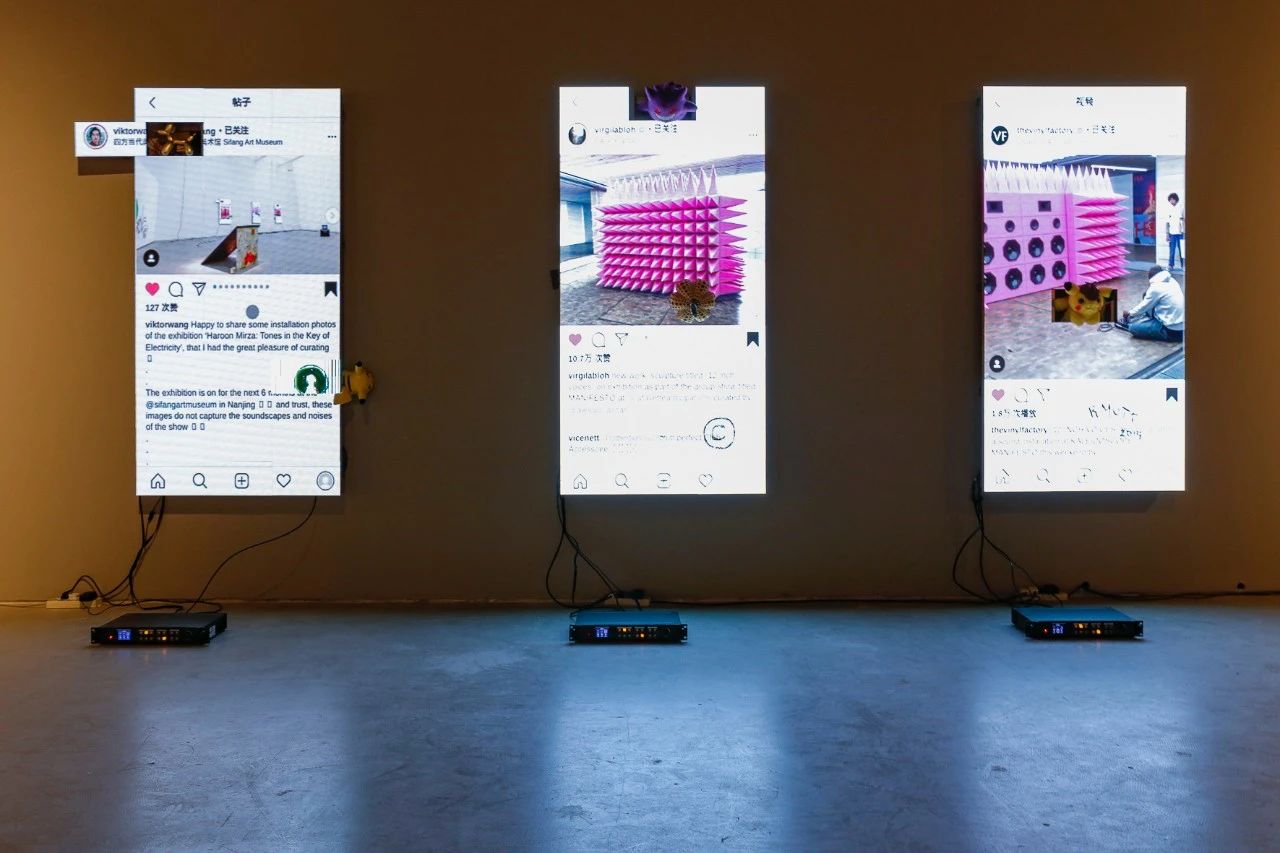 Haroon Mirza, Toy, Biter and Inappropriate Appropriation, 2019,installation view ©CAC
Haroon Mirza, Toy, Biter and Inappropriate Appropriation, 2019,installation view ©CAC
Sometimes a head-on clash could also be necessary in order to provoke more commotions and therefore sensations. When Knowbotic Research installed their New York debut of Minds of Concern at the New Museum in 2002, they would have been beholden to legal implications should they fulfill the work as conceived, and that could have led to potentially shutting down the exhibition and other unpleasant consequences. In this Art Hacking Show, the Knowbotic Research artists had planned to use Security Scanner to unveil the IP addresses of various grassroots organizations and media artists to bring to public attention the vulnerability and security loopholes in cyberspace among these ill-protected front-liners, thus to directly engage in legal practicalities which would have lasting impact in the political ecology of the internet. Such real-world intervention also finds its predecessors in the likes of Dada, Fluxus, Situationists, and even in the provocateurs of Conceptual Art. Hans Haacke, for example, who had repeatedly made his patron museums anxious and uneasy, if not more in recent records of performance art. In Domestic Tension (2007), Wafaa Bilal, the Iraqi-born artist, staged a situation in which highly divided American options on the controversial Iraq war were mirrored by those who were drawn by the temptation of “shooting an Iraqi” (the work’s online tagline) to virtually pull a trigger that via the internet would physically shoot from a robotically controlled gun a paintball at the artist, confined 24/7 in a gallery-transformed living space, and those who came to his defense. Through this unforgiving online exchange, the political complexities of the Iraq war were made open not only symbolically but also experientially, alongside it the mysterious gamification of killing was stripped bare.
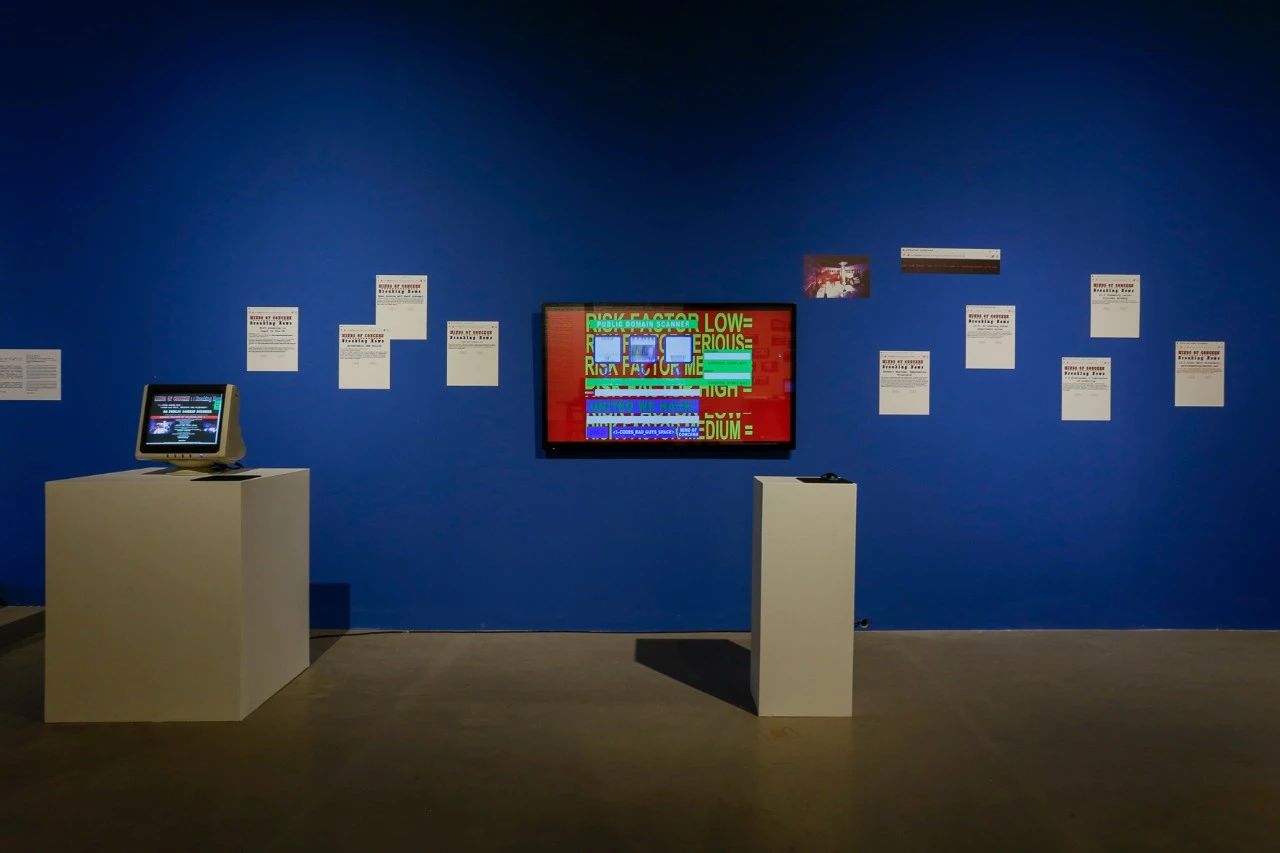 Knowbotic Research, Minds of Concern, 2002,installation view ©CAC
Knowbotic Research, Minds of Concern, 2002,installation view ©CAC
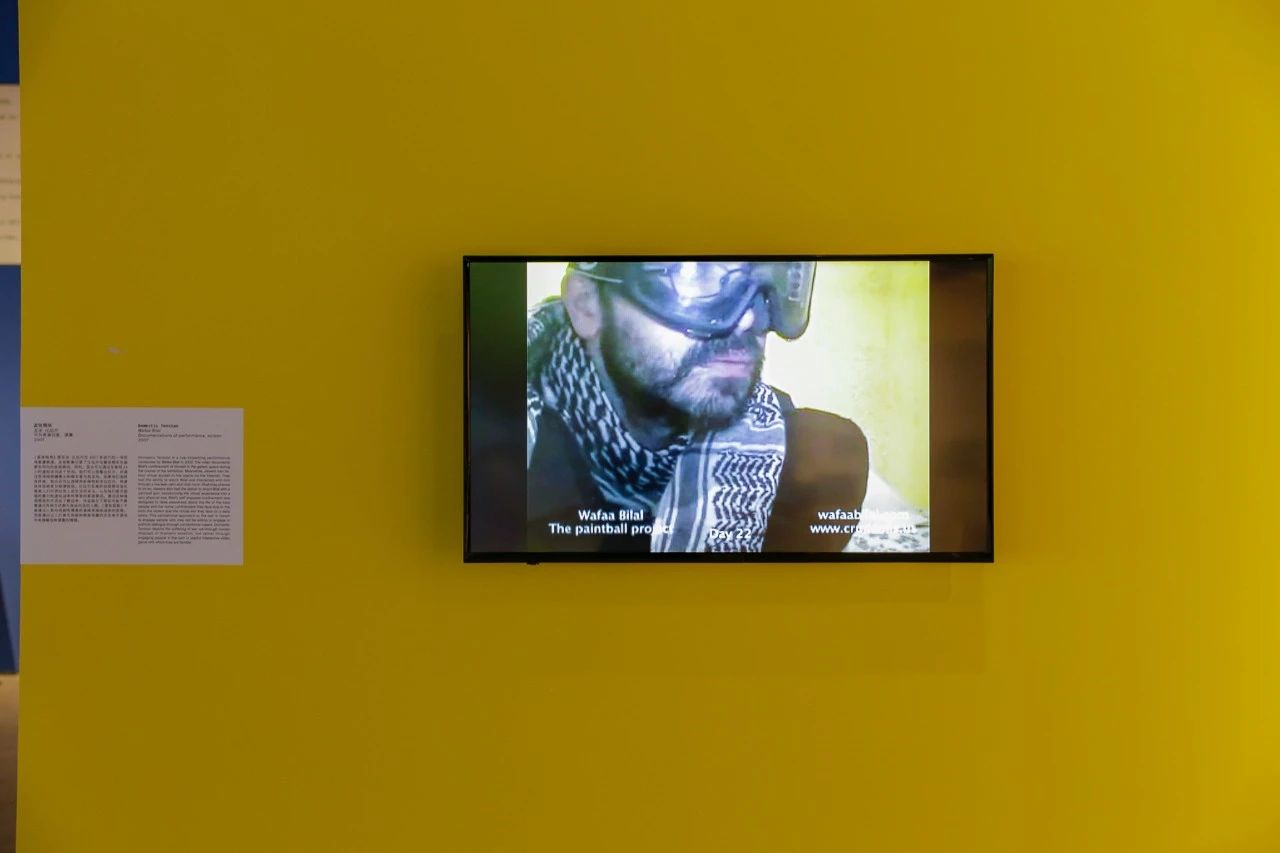 Wafaa Bilal, Domestic Tension,2007,installation view ©CAC
Wafaa Bilal, Domestic Tension,2007,installation view ©CAC
Cultural spaces are also marketplaces, the dialectics of the cultural logic is that art teases the market (Banksy comes to mind, for example) and capital loves art. But as the world of wealth is owned by the one percent, so is the art market. Paolo Cirio determined that the astronomical auction prices should be redistributed via the supposedly democratic reshuffling of the internet. A derivative can be earned by buying a Jasper Johns at a fraction of the Sotheby’s auction price. The artist clearly was serious about the sale but not just striking a symbolic gesture. Real action vs. speculative auction.
In examining contemporary art from the 1970s onward, art historian Hal Foster contended that “The shift in conception — from reality as an effect of representation to the real as a thing of trauma — may be definitive in contemporary art.”[11]Today the traumatic and the abject prevail online as a parallel world of misery and wretchedness. With relentless rants and raves, bombastic swerves and vortex, Ubermorgan once again unapologetically forces upon us a squeamish reality as is rampant in the likes of the ultraright Breitbart publicity, where “transhumanists, fashionable fascists, anti-vaxxers, incels, and Silicon Valley supremacists” roam. Breitbart Red’s stylized propaganda and sensational catchlines are reminiscent of the indelible memory of destruction.
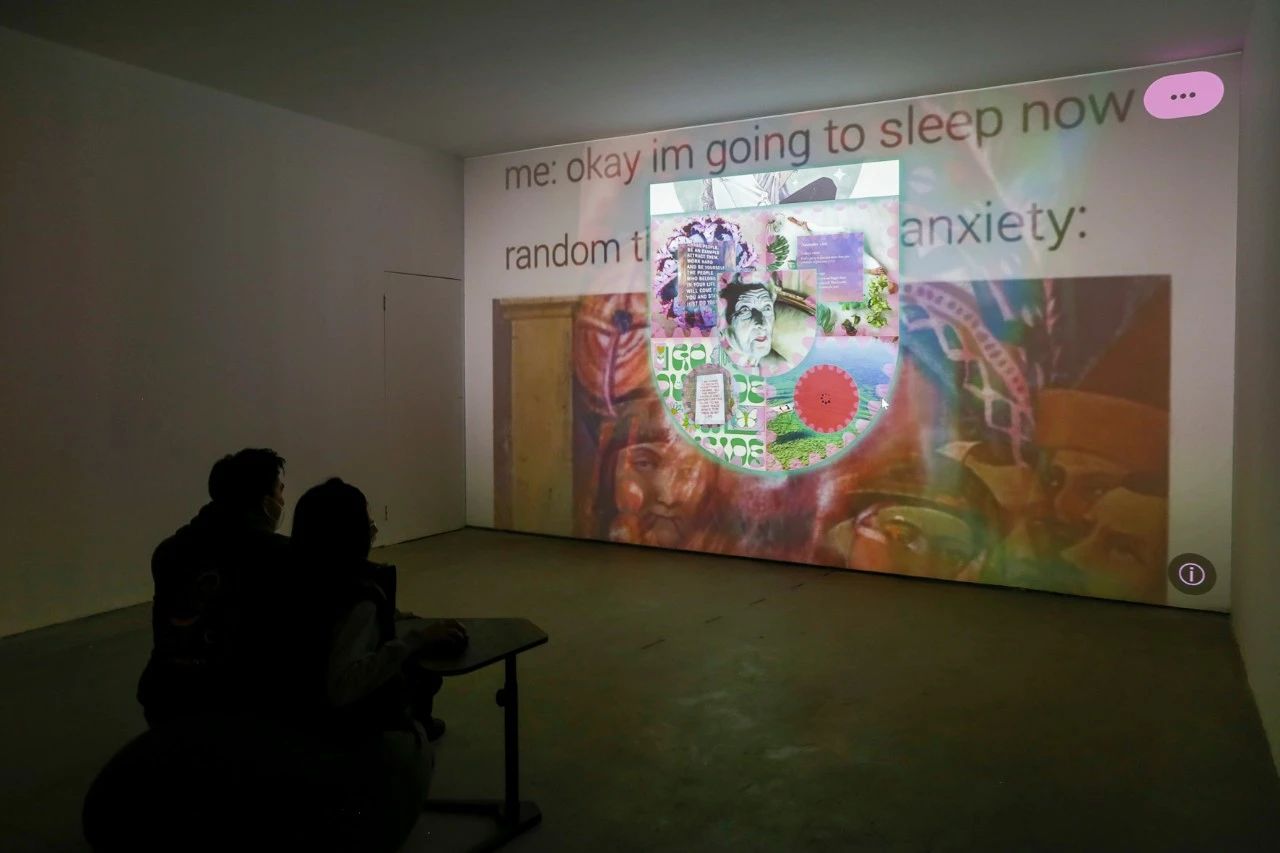 Ubermorgan, Breitbart Red, 2020, installation view ©CAC
Ubermorgan, Breitbart Red, 2020, installation view ©CAC
Disruption comes in many styles and flavors. When Wolfgang Staehle set up The Thing BBS in a basement on White Street in Tribeca in 1991, he wasn’t thinking in such lofty terms as to overthrow something, but rather desired an act of enabling, the act of taking ownership of the network infrastructure, which, by bypassing the encroachment of a corporate network, the German artist saw as the foundation for the nascent potential of Social Sculpture in the digital era, thus seeded the first social media by the name of art. By the same token, People’s Computing, a rare collection of ZHOU Pengan, which is comprised of antiquated artifacts of the DIY group CFido, electronic dictionary, PDA, Flash animations and Opensource wireless firmware hacks, sheds light on the forgotten story of the early Chinese Internet culture during its formative years of the late 1990s and early 2000s. The amateurish enthusiasm and self-propagated autonomy mark a striking similarity with the pioneering spirit of their predecessors. Maciej Wisniewski (Netomat, 2002) set out to create a browser for he doubted Netscape’s or Internet Explorer’s navigational logic, which he thought could fixate a way of looking at the world and cast consumer behaviors in the interest of companies. In the case of Name.Space, artist Paul Garrin, once a student of Nam June Paik, reinvented himself as an entrepreneur so that he could negotiate with the executives at Network Solutions, which managed and controlled top domain names. Name.Space made headline news in the New York Times, The Economist, etc. The artist wanted to run domain names, too, for a romantically wished-for autonomy and for a new model of service as art – much like the Thing BBS's enactment of network as art. Both predated the soon-to-be buzzword of artworld of the 1990s: Relational Aesthetics proposed by the French curator Nicolas Bourriaud.
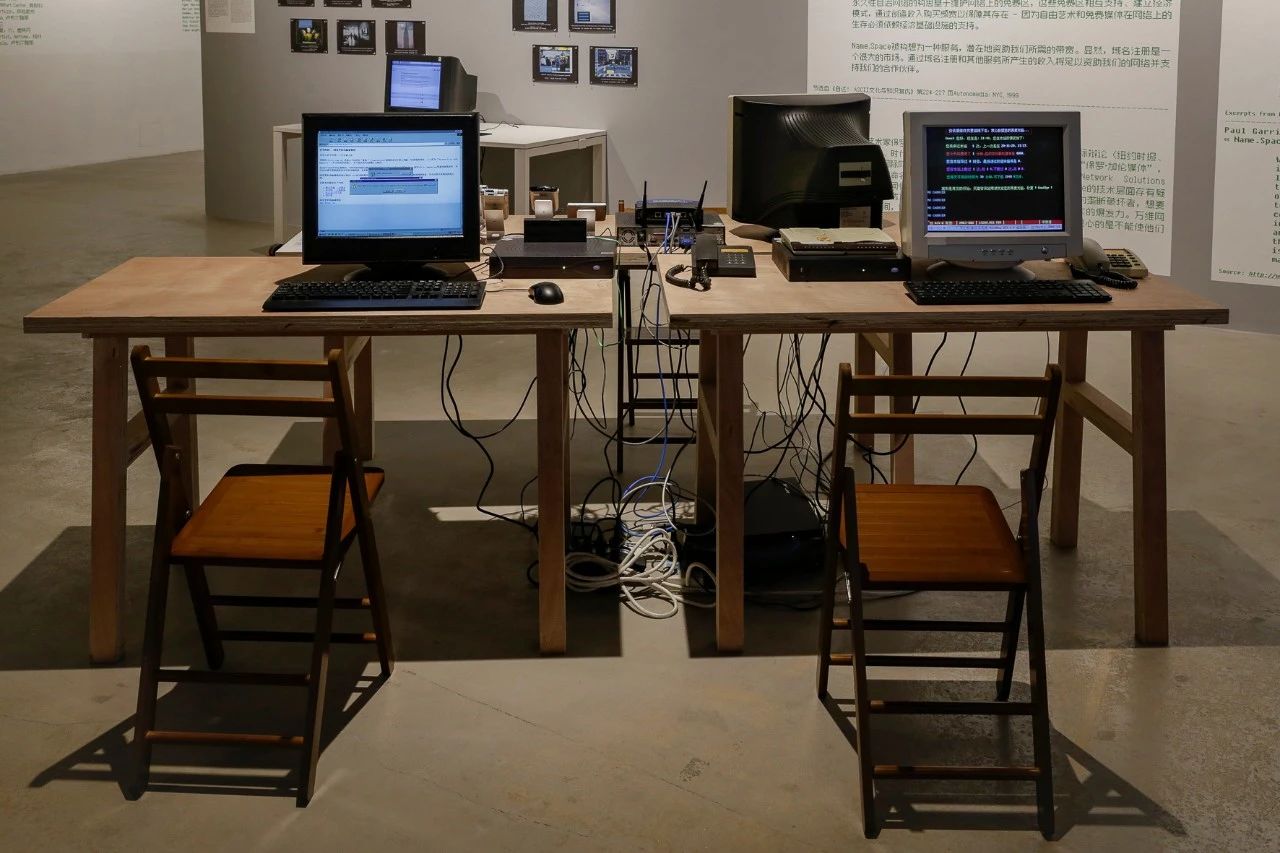 ZHOU Pengan, People’s Computing, 2020, installation view ©CAC
ZHOU Pengan, People’s Computing, 2020, installation view ©CAC
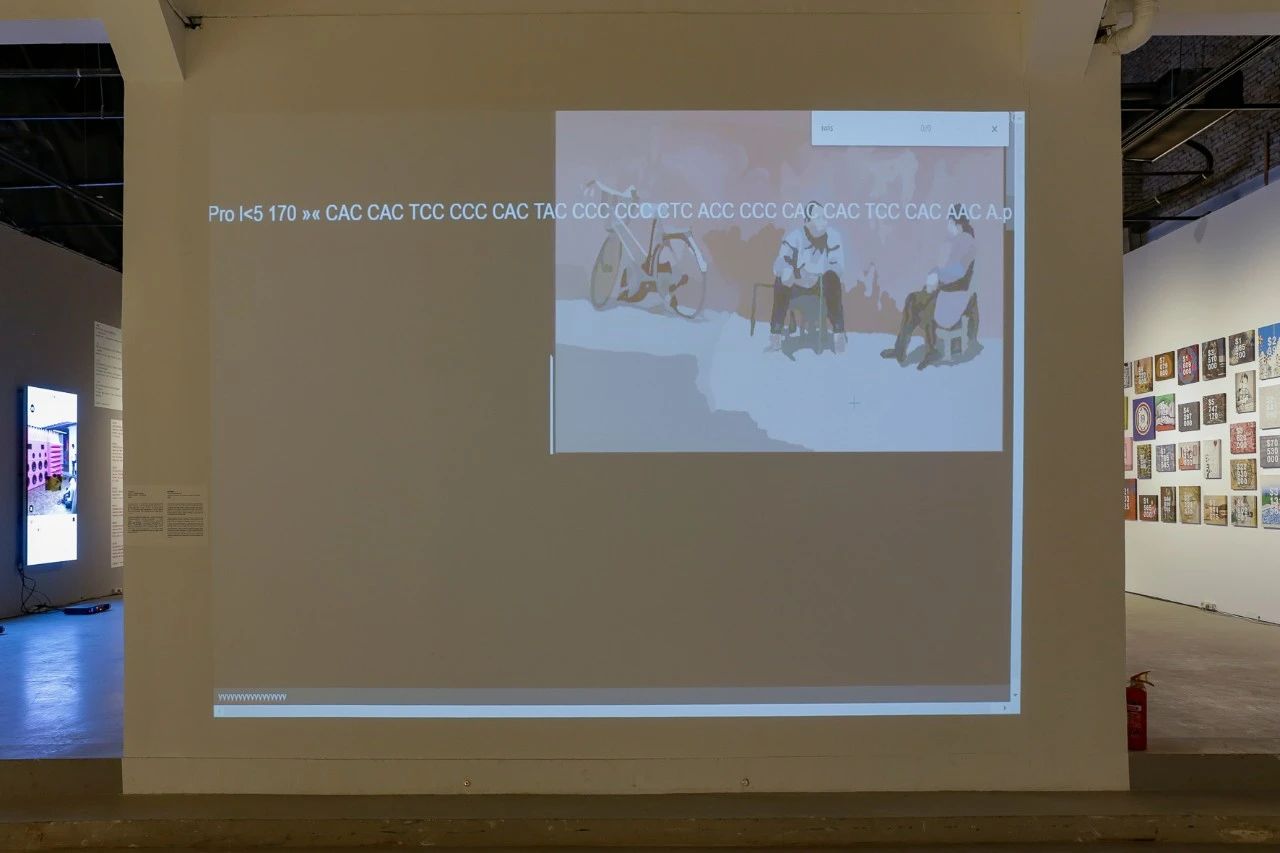 Maciej Wisniewski, Netomat, 2002, installation view ©CAC
Maciej Wisniewski, Netomat, 2002, installation view ©CAC
Disruption elicits invitations, too. Ursula Endlicher (Light and Dark Networks, 2011-2013) and the artist duo Exonemo (0 to 1 / 1 to 0, 2019), among others, were commissioned to sabotage the Whitney Museum of American Art by taking over whitney.org each day at the liminal moments of sunrise and sunset by the invited artist’s self-intuited references and preferences. The precious ten to thirty seconds mark the institution’s generous consent of the validity of net art, and an homage to the self-styled reverie of the avant-garde as Christiane Paul, curator of Whitney’s art port, the museum’s portal to the internet art, spoke about the program; “Using whitney.org as their habitat, Sunrise/Sunset projects disrupt, replace, or engage with the museum website as an information environment.”[12] Perhaps it is a euphemism for a new kind of Institutional Critique of the information age. Capital absorbs, culture assimilates, and art re-appropriates, much like gravitation pulls.
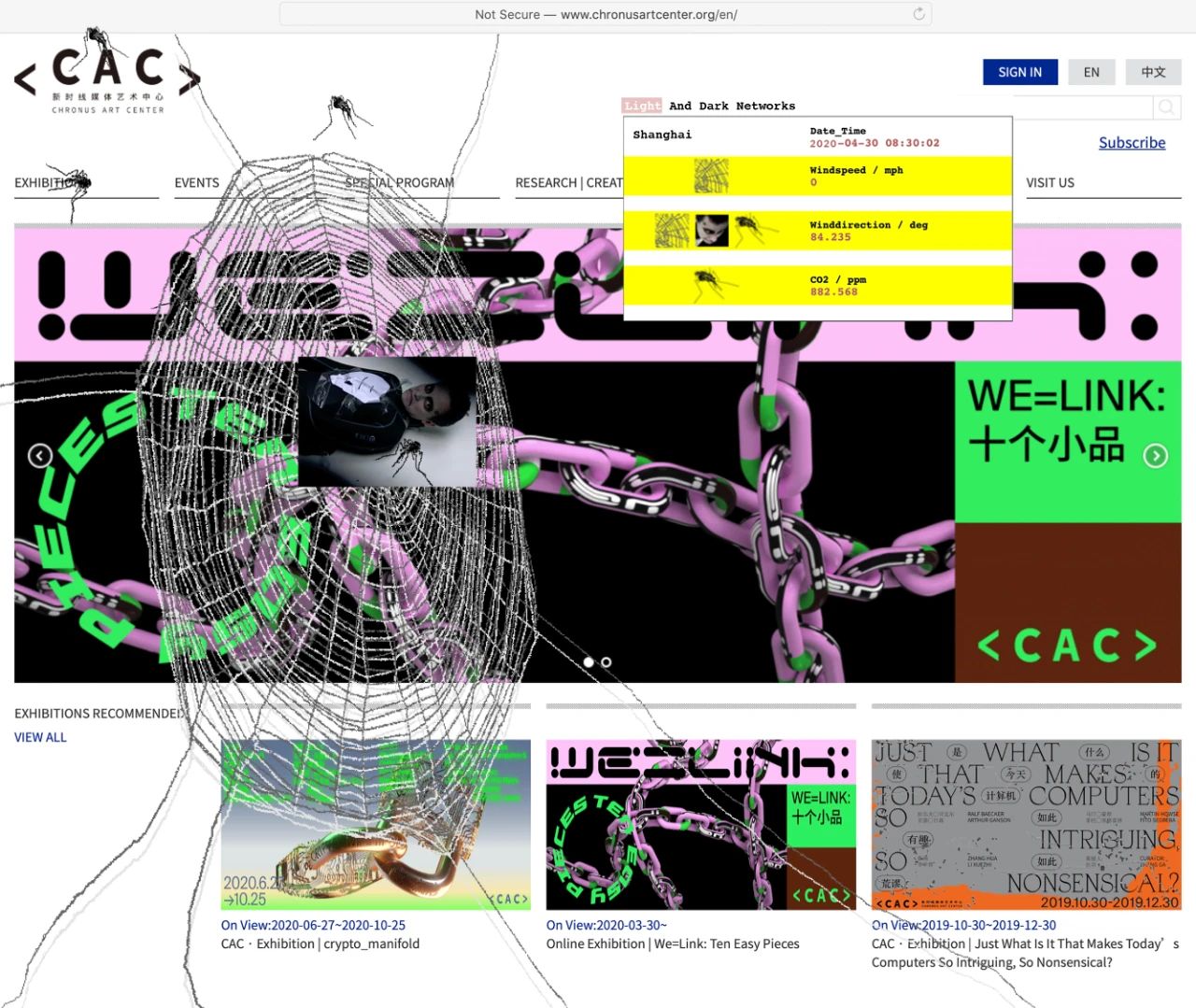 Ursula Endlicher, Light and Dark Networks, 2020, demonstration ©the artist
Ursula Endlicher, Light and Dark Networks, 2020, demonstration ©the artist
When Radical Software Group released Canivore, an open source packet sniffing library, they offered their own line of flight about data types, operators, control structures and functions in a flare of manifesto, not unlike the romantic outcry of the world-change ethos of the Futurists, they called it Notes for a Liberated Computer Language.[13] Although Carnivore in the end was no more than a data visualization toolkit, its radicality lies in its intrinsic disobedience to the given norms, whether the clandestine appropriation of FBI surveillance software or the radicalization of programming language itself. It was only later revealed that the core members of the group, Eugene Thacker and Alex Galloway, were on their way to become radical theorists of media culture.
The hacker instinct has always been part of the genes of net art. It still thrives today after a short pause during a period some dubbed the post-internet, which more or less was a misnomer if not a misconception. In default filename tv (2019), Everest Pipkin exposed the backstage logic of YouTube videos. His mesmerizing installation of Lacework (2020) again is an ingenuous improvisation of one hacker’s persistence to turn vastly mundane datasets into a new expression of generative sublime. In We leak Too (2020), Leon Eckert and Vytas Jankauskas have extended the legacy of Carnivore to give a fresh 2020 update of the original, albeit quite idiosyncratically. The visual is now substituted by the audible to resonate with the surrounding sound of Alexas. “Every time a packet goes through its local network, the device will announce it being logged. If a plain-text packet gets intercepted, its content will be read aloud.”[14] If data visualization is a representation of probable messages, then We leak unforgivingly tells the uninterrupted truth. Noise removed, entropy defeated, and pure information attained.
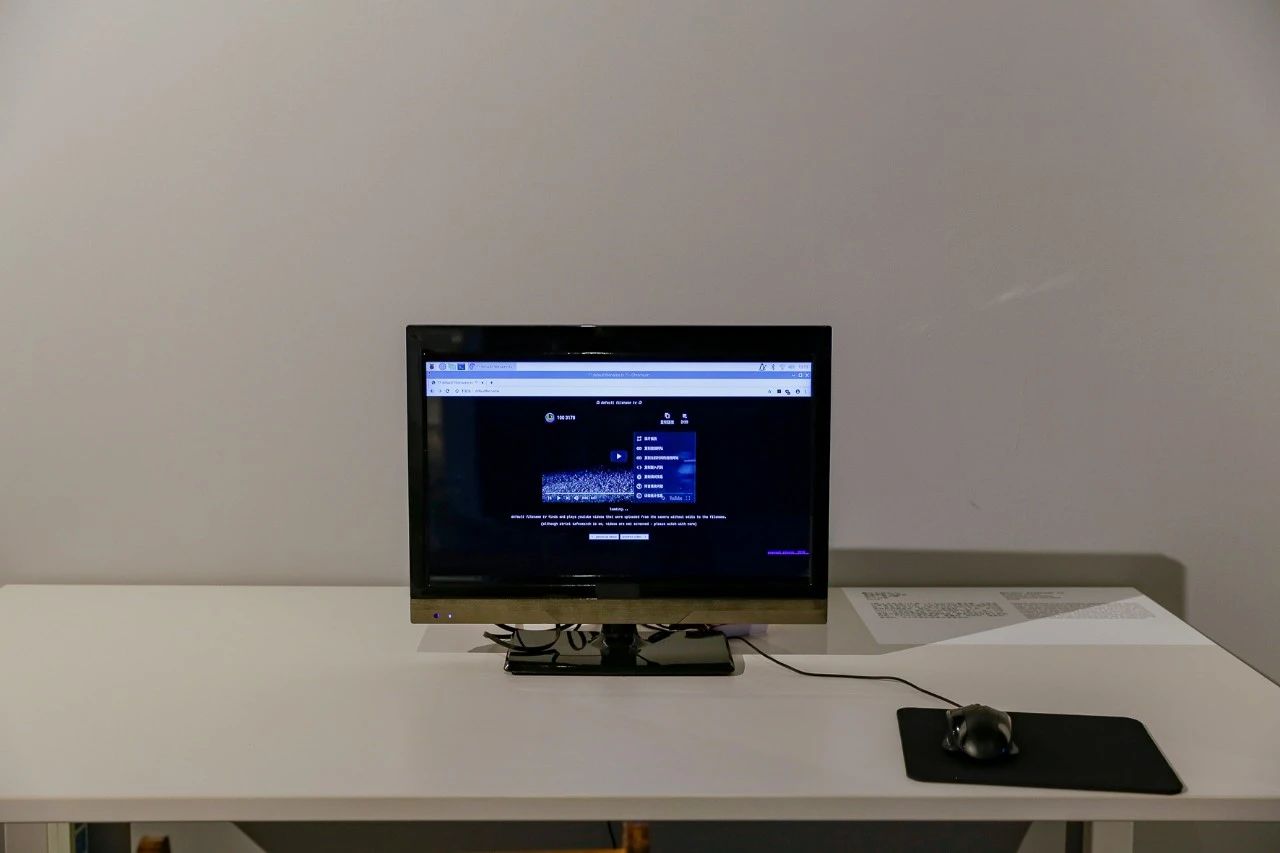 Everest Pipkin, default filename tv, 2019, installation view ©CAC
Everest Pipkin, default filename tv, 2019, installation view ©CAC
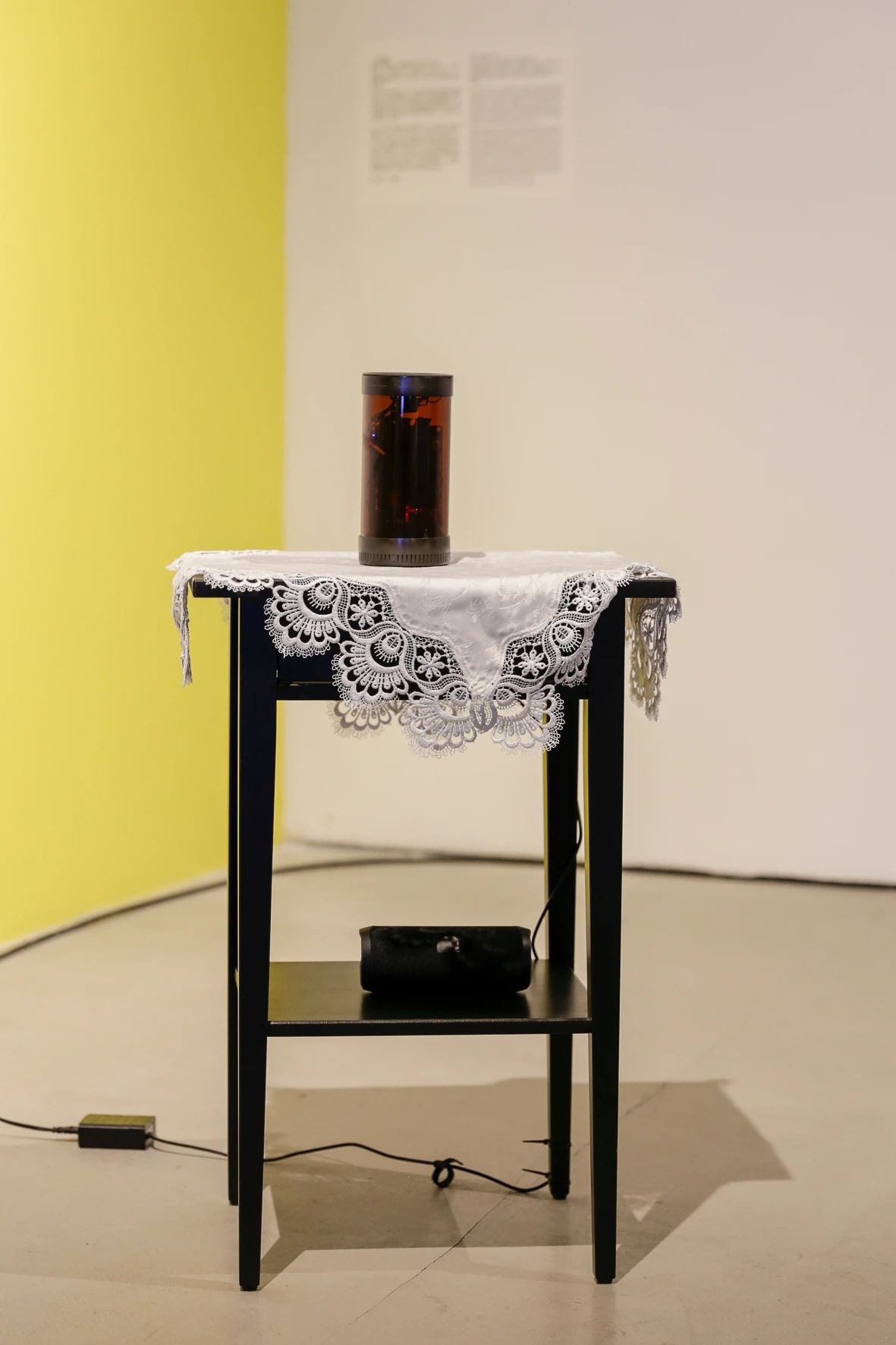 Leon Eckert and Vytas Jankauskas, We leak Too, 2020, installation view ©CAC
Leon Eckert and Vytas Jankauskas, We leak Too, 2020, installation view ©CAC
Artists were sincerely excited and inspired when the arrival of the internet finally seemed capable of fulfilling the telematic embrace that had been dreamt about for decades. It was not only a way to communicate bi-directionally or through multi-nodal hyperlinks as promised in a decentralized network, but also through which a new form of autonomy implicit of a literal realization of the Beuysian “Everyone is an artist” could come true or that now, at last, everyone could indeed have his / her fifteen minutes of fame. Net Art Generator (Cornelia Sollfrank, 1999) was a classic of such aspirations. That tradition continued to update itself into mobile phones with the 2013 creation of Raoul Pictor Mega Painter (Hervé Graumann / Matthieu Cherubini, 2013). The App store tagline reads “With Raoul Pictor Mega Painter you can make art whenever you want and wherever you want.”
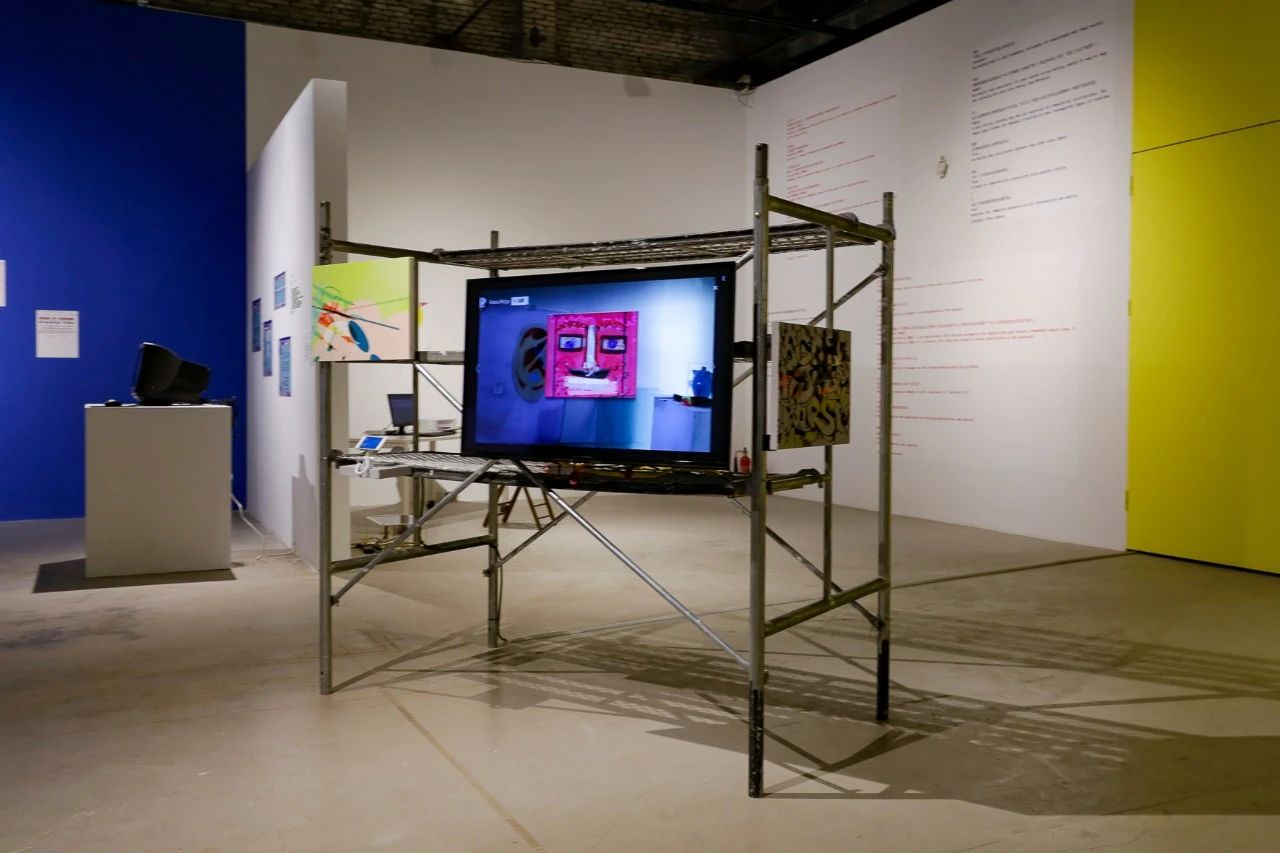 Hervé Graumann and Matthieu Cherubini, Mega Painter , 2013, installation view ©CAC
Hervé Graumann and Matthieu Cherubini, Mega Painter , 2013, installation view ©CAC
At a time when Instagram, YouTube, TikTok, Facebook and WeChat reign supreme, online social networks have grown ever more homogenized, it is cognition capitalism working at its best: consumption of freedom and democracy are among the most profitable under the scrutiny of corporate gazes. Guo Chen set out to dispute such premediated habitats of social media. In Wind Verification (2020) he transforms user uploaded video clips of the invisible force of wind into embodied sensory experience in the physical space of the gallery – a fan blows out the wind aligning with the directions of virtual wind in the video. It is an illuminating gesture of the unanimous many weaved into the potential of a storm in the making in a world in which the unreal is no less real than the real.
Lauran Lee McCarthy teamed with Kyle McDonald have distributed a product that “tracks, analyzes, and auto-manages your relationships.”[15] The app pplkpr (2015) conveniently automates one’s social life. Like many of her works, the overly optimistic anticipation of technologically optimized life is often infused with sarcasm and castigation about the very things it proselytizes. Likewise, in Later Date (2020) her seemingly melancholic sentimentalism was nevertheless evocative of wit and hope. It is the “zany, cute and interesting” as the aesthetic supplements (as opposed to the dire prescriptions of Hal Foster) for a critique of the new reality, as Sianne Ngai aptly articulated in her 2012 volume Our Aesthetic Categories.
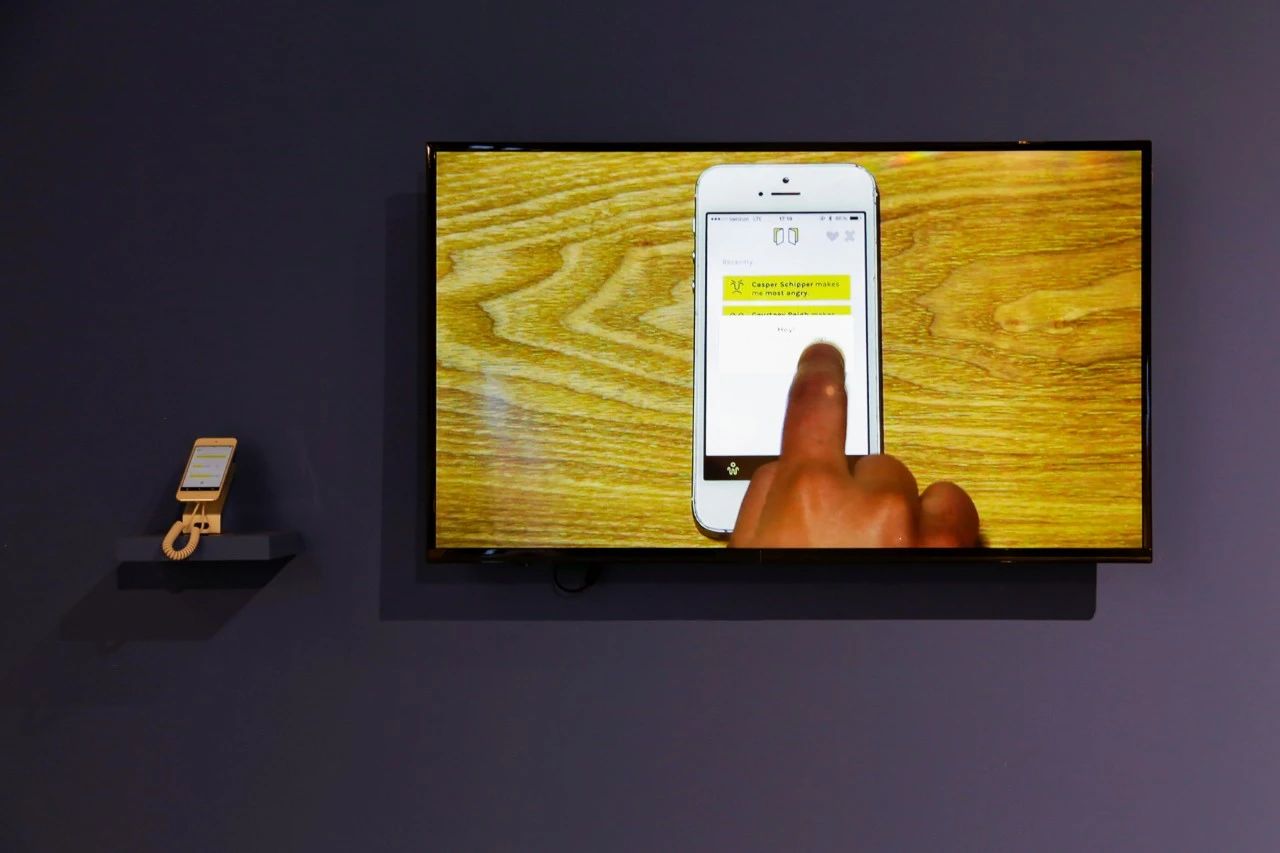 Lauran Lee McCarthy and Kyle McDonald, pplkpr, 2015, installation view ©CAC
Lauran Lee McCarthy and Kyle McDonald, pplkpr, 2015, installation view ©CAC
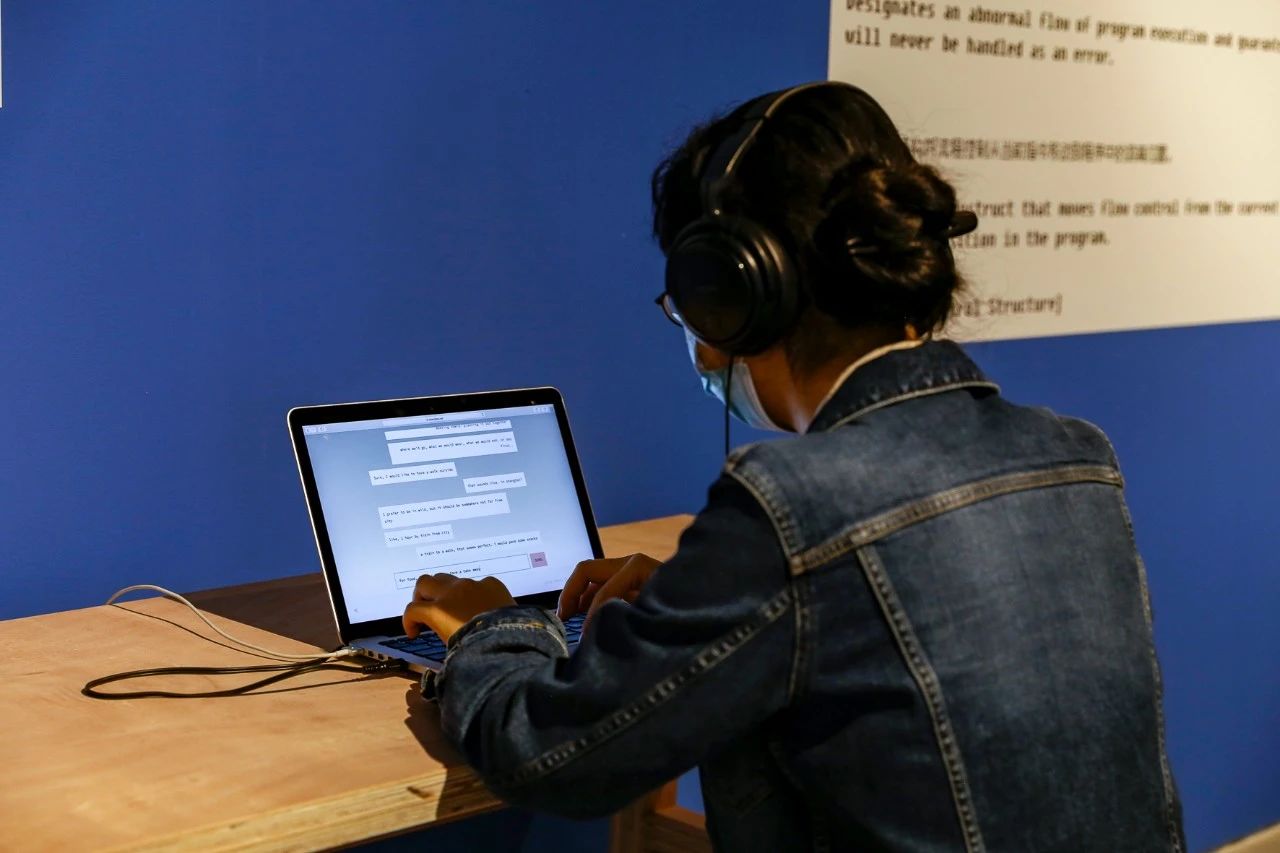 Lauran Lee McCarthy, Later Date, 2020, installation view ©CAC
Lauran Lee McCarthy, Later Date, 2020, installation view ©CAC
When Heath Bunting interrupted the routines of the Kings Cross Station in London on August 4, 1994 by inviting people, via email, to call in from all over the world, it seemed reminiscent of John Cage’s 1966 ambitious episode Variation VII, during which he had ten telephone lines set up in various locations in New York City and the incoming voices would be mixed and amplified with other mechanical (blender, juicer, fan), environmental (Geiger meter), and physiological (pulse generator)[16] sounds onside transmitted via sensors by the performers at the Armory for the legendary 9 Evenings of performance. Of course, Bunting's setup was not nearly as sophisticated as Cage’s and the purpose was also different. It foreshadowed that net art was from the beginning not just something that happened on a web browser, but a much more extended scope of operation even though in those days the net could mostly only be experienced through a browser window. Today, we ever more understand that the net is the membranes of a symbiosis which connects machines with blood vessels, in dialogue with elongated rivers and lands, intercepts wind and rain, permeates from the tangible to the invisible. The networks bricolage silicon with flesh, traverse the organic through to the inorganic, fusing humans and nonhuman, all reciprocal and comingling. A new generation of artists are particularly sensitive toward this precarious posthuman condition in which we live and by which they make art. An intricate installation triggered by online users that in turn feeds back to the browser behavior with the unflattering title Miasma of the Rocks (CHEN Pengfei, LIU Xing, LIANG Yuhong, XU Haomin and ZHAO Hua, 2020) is characteristic of such reciprocity of human-machine mutuality rippling through bodies and networks, akin to the posthuman explication in the words of Cary Wolfe:
“It comes both before and after humanism: before in the sense that it names the embodiment and embeddedness of the human being in not just its biological but also its technological world, the prosthetic coevolution of the human animal with the technicity of tools and external archival mechanism…. [It] comes after in the sense that it names a historical moment in which the decentering of human by its imbrication in technical, medical, informatic, and economic networks is increasingly impossible to ignore.”[17]
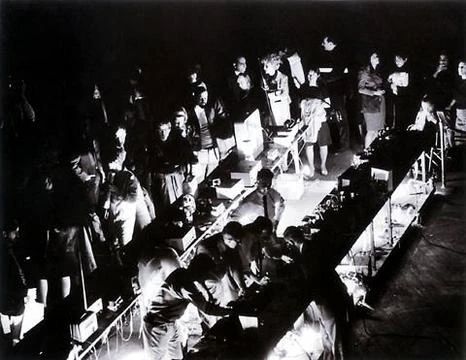 John Cage, Variation VII, 1966
John Cage, Variation VII, 1966
image source: http://www.mediaartnet.org/works/variations-vii/
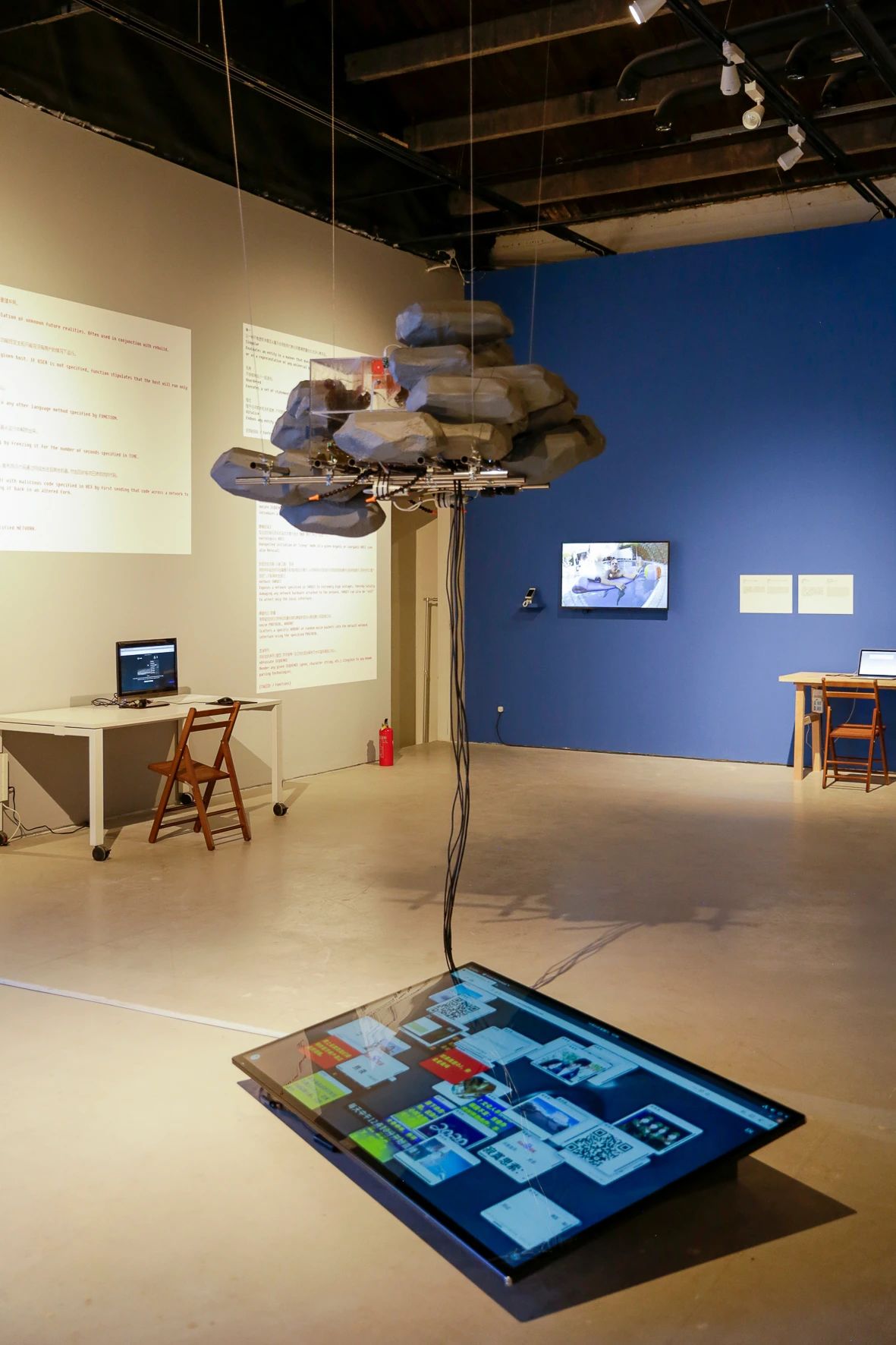 CHEN Pengfei, LIU Xing, LIANG Yuhong, XU Haomin and ZHAO Hua, Miasma of the Rocks, 2020, installation view ©CAC
CHEN Pengfei, LIU Xing, LIANG Yuhong, XU Haomin and ZHAO Hua, Miasma of the Rocks, 2020, installation view ©CAC
ZKM | Center for Art and Media Karlsruhe was prescient to organize a show in 1999 after “the dead end of net art,” titled net_condition before most art institutions had come to an awakening that a new epoch had descended and it would be defined by the network. The net condition has reaffirmed, by now, a perpetual condition, and it is a posthuman condition with the net condition as its circulatory and respiratory prerequisites. In a world that is stricken by a rampant pandemic and virulent misinformation, a world bankrupted by corporate rapacity, a world of tumults and crises, accelerated by glorious artificial intelligence in the feedforward anticipation of the Kurzweilian transhuman singularity; a world of hardened passion and redemption, a world in every way reminiscent of the fertile ground in which the Avant-garde germinated and thrived, net art, the last avant-garde of the 20th century, may once again at this “turning point” take up that Quixotic spirit of intrepidity and strive on, once again from the periphery and the fringe – with a little mischief, a pinch of agitation too, via action, through the beautiful, and by sideways, to remake history.
[1]Barbara London, Video Art the First Fifty Years (New York: Phaiden Press, 2020), p.184.
[2]Josephine Bosma, Nettitudes: Lets Talk Net Art (Rotterdam: NAi Publications,2011), p.22 - 61.
[3]Dieter Daniels & Gunther Reisinger, “Reverse Engineering Modernism with the Last Avant-garde” in Net Pioneers 1.0, eds. Dieter Daniels & Gunther Reisinger (Rotterdam: NAi Publications,2009), p.15.
[4] Ibid., p.31.
[5] Ibid., p.27.
[6] Net Pioneers 1.0, p.31.
[7] https://rhizome.org/editorial/2017/mar/02/the-copy-and-the-paste/, accessed 10/18/2020
[8]https://rhizome.org/editorial/2017/mar/03/repo-man/. accessed 10/18/2020
[9] https://en.wikipedia.org/wiki/Cabaret_Voltaire_(Zurich), accessed 10/18/2020
[10]Marcel Duchamp’s female alter ego.
[11]Hal Foster, The Return of the Real (Cambridge: The MIT Press, 1996), p.146.
[12] https://whitney.org/artport/commissions/sunrise-sunset. accessed 10/18/2020
[13] http://r-s-g.org/LCL/
[14]From the work description
[15] https://lauren-mccarthy.com/pplkpr. accessed 10/18/2020
[16]http://www.medienkunstnetz.de/works/variations-vii/; https://johncage.org/pp/John-Cage-Work-Detail.cfm?work_ID=272. accessed 10/18/2020
[17]Cary Wolfe, What is Posthumanism (Minneapolis: University of Minnesota Press, 2010), p.XV.

